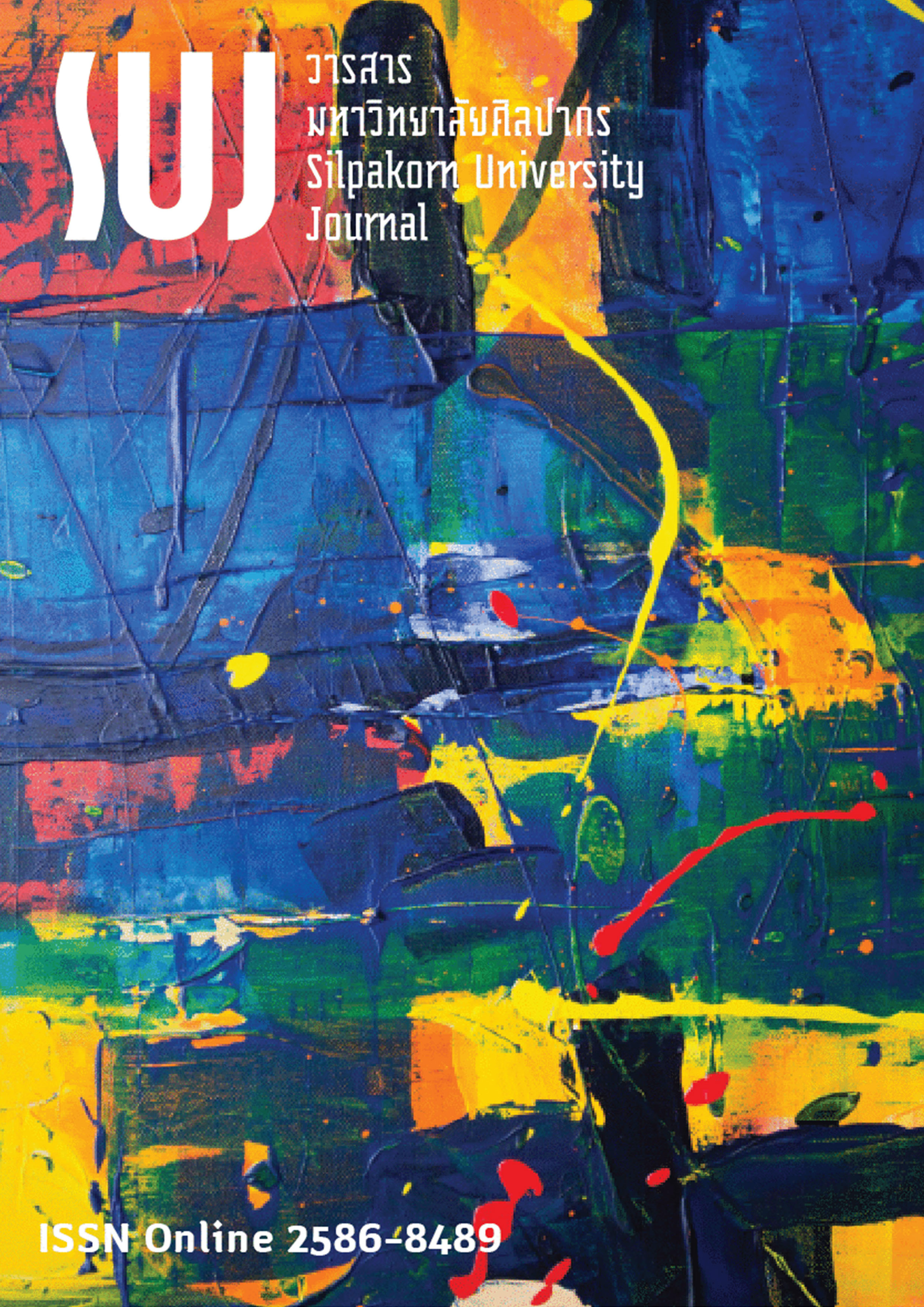ศิลปะสื่อสมัยใหม่ และกระบวนการเกมิฟิเคชั่น จากความเปลี่ยนแปลงมโนทัศน์วัฒนธรรมจีน - ไทย ในผลงาน “21241” (“21241” New media art and gamification on the change of Chinese - Thai cultural concept)
Main Article Content
Abstract
บทความนี้เรียบเรียงขึ้นเพื่ออภิปรายวิธีการและแนวคิดในการสร้างสรรค์ผลงานทางทัศนศิลป์ “21241” ซึ่งเป็นส่วนหนึ่งของการวิจัยเรื่อง “การศึกษาอุปกรณ์ประกอบพิธีกรรมจีน - ไทย สู่การสร้างสรรค์ผลงานศิลปะแนวเกมิฟิเคชั่น” ในบทความนี้ผู้เขียนกล่าวถึงการศึกษาค้นคว้าเชิงวัฒนธรรมในอุปกรณ์ประกอบพิธีกรรมจีนชนิดหนึ่งที่รู้จักอย่างกว้างขวางในประเทศไทย คือ เซียมซี โดยตั้งโจทย์ในการออกแบบจากบรรยากาศแวดล้อมทางวัฒนธรรมจีนที่กำลังมีแนวโน้มผ่อนคลายความเคร่งครัดในการสืบทอดลงท่ามกลางอิทธิพลของกระแสวัฒนธรรมมวลชนในยุคโลกาภิวัตน์ ผู้เขียนวิเคราะห์ด้วยทฤษฎีทางสุนทรียศาสตร์แบบหลังสมัยใหม่ โดยบูรณาการความรู้ทางมนุษยศาสตร์เข้ากับศิลปะการออกแบบด้วยการใช้กระบวนการเกม (gamification) ร่วมกับรูปแบบศิลปะสื่อเทคโนโลยีสมัยใหม่ (new media art) และสุนทรียะของศิลปะไร้ค่า (kitsch) เพื่อศึกษาศิลปกรรมเชิงสัญลักษณ์ในอุปกรณ์ที่ปรากฏในพิธีกรรม โดยมุ่งสร้างศักยภาพทางการเรียนรู้ด้วยศิลปะจากการศึกษาเชิงวัฒนธรรมให้เป็นส่วนหนึ่งในกระบวนการสร้างการเปลี่ยนแปลงทางสังคมด้วยการใช้แนวคิดการศึกษาเชิงหรรษา (edutainment) ในกระบวนการเกม ร่วมกับวิธีการทางสุนทรียศาสตร์ที่มุ่งสร้างความสนุกสนาน ซึมซับเนื้อหาผ่านกระบวนการเล่น (play process) สร้างสภาพแวดล้อมที่กระตุ้นการเรียนรู้ผ่านการปฏิสัมพันธ์ ความใกล้ชิด (intimacy) และการมีส่วนร่วม เพื่อขยายขอบข่ายวัฒนธรรมไปสู่เรื่องการออกแบบและไปสู่กิจกรรมอื่น ๆ ในชีวิตประจำวันของมนุษย์
This article has been compiled to discuss methods and concepts in the creation of visual arts “21241” which is part of the research on “The studies on Chino - Thai ceremony’s materials for gamification-art creation.” In this article, the author discusses cultural research on one of the most widely known Chinese ritual devices in Thailand, “Siam Si” (Kau Chim or Chinese fortune sticks). The theme for this design is based on Chinese cultural environment that is likely to have undergone a less intense inheritance among the influence of mass culture in the globalization era. The research was conducted by incorporating a post-modern aesthetic approach, humanistic knowledge, gamification theory, new media art and kitsch style. This is to study symbols implied in Chinese - Thai art that appears in rituals and it also suggests a method to create artistic learning potential and people’s intimacy through this cultural edutainment and the game play process. Through these, the research was aimed to develop people’s potential to appreciate art through the integration of cultural studies, edutainment, and gamification. Moreover, it is intended to be part of the process to encourage social changes and expand the cultural scope to other activities in everyday life.
Downloads
Article Details

This work is licensed under a Creative Commons Attribution-NonCommercial-NoDerivatives 4.0 International License.
References
Adorno, T. W. (1944). The Culture Industry. Translated by Somliat Tangnamo. [Online]. Retrieved July 10, 2021 from http://midnightuniv.tumrai.com/fineartcmu2001/newpage21.html
Chalermpantusak, Wararak. (2013). Concept of Globalization (แนวคิดเกี่ยวกับโลกาภิวัตน์). In Politic analysis (การวิเคราะห์การเมือง), (pp. 2-55). Bangkok: Sukhothai Thammathirat University.
Chantanayingyong, W. (2020). The Soft Power of the EU: The Promotion of Normative Values through the European eighborhood policy. Journal of European Studies, 26(1): 81-119.
Masona, D. (2009). Conceptual Art. Translated by Achima Thadsachan. Bangkok: The Great Fine Art Company Limited.
Mitpakdee, Pannita. (2019). Before the Creative Economy (ก่อนเศรษฐกิจจะสร้างสรรค์). Creative Thailand, 9(12): 14-15.
Nakasan, Nataya, & Nakasan, Chawanat. (2016). Game: Innovation for Creative Education (เกม: นวัตกรรมเพื่อการศึกษาเชิงสร้างสรรค์). Romphruek Journal, 34(3): 160-182.
Rattanawisutamorn, Theerarat. (2011). Edutainment (มิติใหม่แห่งการศึกษา). FEU Academic Review, 4(2): 44-50.
Santitayawong, Sansern. (2017). 20th Century Art (ศิลปะในศตวรรษที่ 20). Nakhon Pathom: Silpakorn University.
Schneider, D. J. (2004). The Psychology of Stereotyping. New York: The Guilford Press.
The Must Share News Team. (2019). Chinese God of Fortune Goes Viral in Thailand after K-Pop Singer Sets It as Her Phone Background. [Online]. Retrieved August 4, 2021 from https://mustsharenews.com/god-of-fortune-lisa/
Tondello, G. (2019). Dynamic Personalization of Gameful Interactive Systems. Ontario: University of Waterloo.


